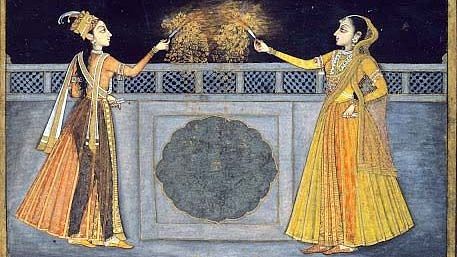
Delhi’s toxic smog has made global headlines for years — with US President Donald Trump making the most recent jibe at India’s ‘filthy’ air. Yet, year after year, some Hindu groups have been viciously protective of their ‘right’ to celebrate Diwali as per traditions — that is, by bursting polluting firecrackers.
Every year, suggestions to ban or restrict the use of firecrackers are met with accusations that it is all part of a concerted agenda to target Hindu festivals.
This year has been no different.
Recently, spokespersons of the Vishwa Hindu Parishad (VHP) and Swadeshi Jagran Manch opposed the ban on firecrackers imposed by the National Green Tribunal (NGT), saying that “use of crackers is deeply linked with Diwali celebration.” An environmental call is often projected as an attack on Hinduism.
But is it?
“The use of fireworks in the celebration of Diwali, which is so common in India now, must have come into existence after about 1400 AD, when gunpowder came to be used in Indian warfare.”
This oft-quoted excerpt from late historian Parshuram Krishna Gode’s The History of Fireworks in India between A.D. 1400 and 1900 — published in 1950 — shows that the festival of Diwali predates the use of firecrackers.
So, the assertion that firecrackers are an integral part of Diwali and, by extension, Hindu culture is a bit overstretched.
Someone else’s legacy
Hinduism is believed to be the oldest religion in this world, with its origins dating back to more than 4,000 years ago. Deepavali, which is interpreted as the festival of lights, dates back to at least 2,500 years ago.
That is much before the Chinese invented gunpowder in the 9th century. According to historians, it was not until the 13th century that firecrackers made their way into India through the Mongols.
According to Gode’s account, Kautukachintamani — a Sanskrit volume by reputed royal emperor-author Gajapati Prataparudradeva (1497-1539) in Odisha — had descriptions of formulas to manufacture fireworks. It is possible that Chinese formulas were modified with the use of Indian substitutes because the ingredients were not available in India.
Even a few centuries later, the use of fireworks was limited to the affluent or the royalty. They became a sign of prosperity and grandeur during the Mughal era — and noted historians say that firework displays were common during weddings, coronations and Islamic festivals such as Shab-e-Barat.
The use of firecrackers during Diwali did not likely start before the 18th century, when Maratha rulers would organise firework displays for the general public.
It was not until after Independence — when Indian industries started manufacturing firecrackers and Sivakasi in Tamil Nadu emerged as a hub — that the general population began the widespread use of firecrackers during Diwali.
Firecrackers are thus a legacy of the Chinese and the Mughals, which the Hindutva groups are usually keen on distancing themselves from.
Understand the risk
Being a Hindu myself, the history of firecrackers and how far back the tradition of using them on Diwali goes, hold no particular significance for me.
What is more important is that firecrackers leave a toxic mix of heavy metals, smoke and dust in the air — sometimes for days — putting everyone’s health at risk.
A study conducted by researchers in Pune last year shows that a person can be exposed to anywhere between 4,800 and 64,500 micrograms per cubic metre of PM 2.5 within a few minutes.
The World Health Organization (WHO)’s air quality guidelines recommend that over 24 hours, an average of 25 micrograms per cubic metre of PM2.5 exposure is considered safe.
It’s not just firecrackers
Even so, bursting firecrackers just for a few hours should not have had population-wide consequences, but for a number of mitigating factors.
The cold air and the lack of favourable winds do not let the smoke from the crackers dissipate. Instead, it hangs around, exposing even those who did not participate in the festivities.
Along with this, north India already has high levels of pollution, owing to the smoke blowing in from stubble burning in Punjab and Haryana as well as the existence of several polluting industries.
While it is true that firecrackers are not the main source of pollution, they worsen the air quality for several days — something that could altogether be avoided if we have the cooperation of the self-proclaimed guardians of Hindu culture.
Irrespective of whether the use of firecrackers on Diwali is a recent phenomenon or deep-rooted part of our tradition, the fact remains that the culture predates the modern-day evil of pollution.
If only our ancestors had pollution monitors that touched the maximum reading on Diwali nights, perhaps they too would have limited their celebrations to lighting diyas.
Views are personal.
Subscribe to our channels on YouTube & Telegram
Why news media is in crisis & How you can fix it
India needs free, fair, non-hyphenated and questioning journalism even more as it faces multiple crises.
But the news media is in a crisis of its own. There have been brutal layoffs and pay-cuts. The best of journalism is shrinking, yielding to crude prime-time spectacle.
ThePrint has the finest young reporters, columnists and editors working for it. Sustaining journalism of this quality needs smart and thinking people like you to pay for it. Whether you live in India or overseas, you can do it here.